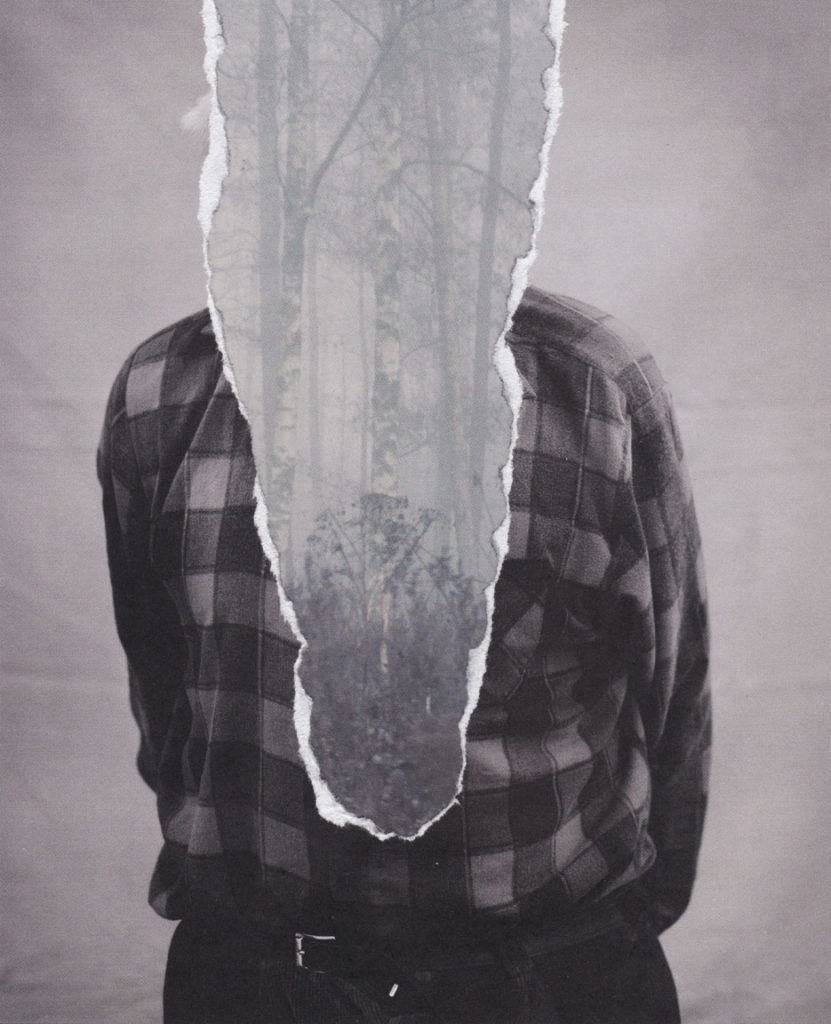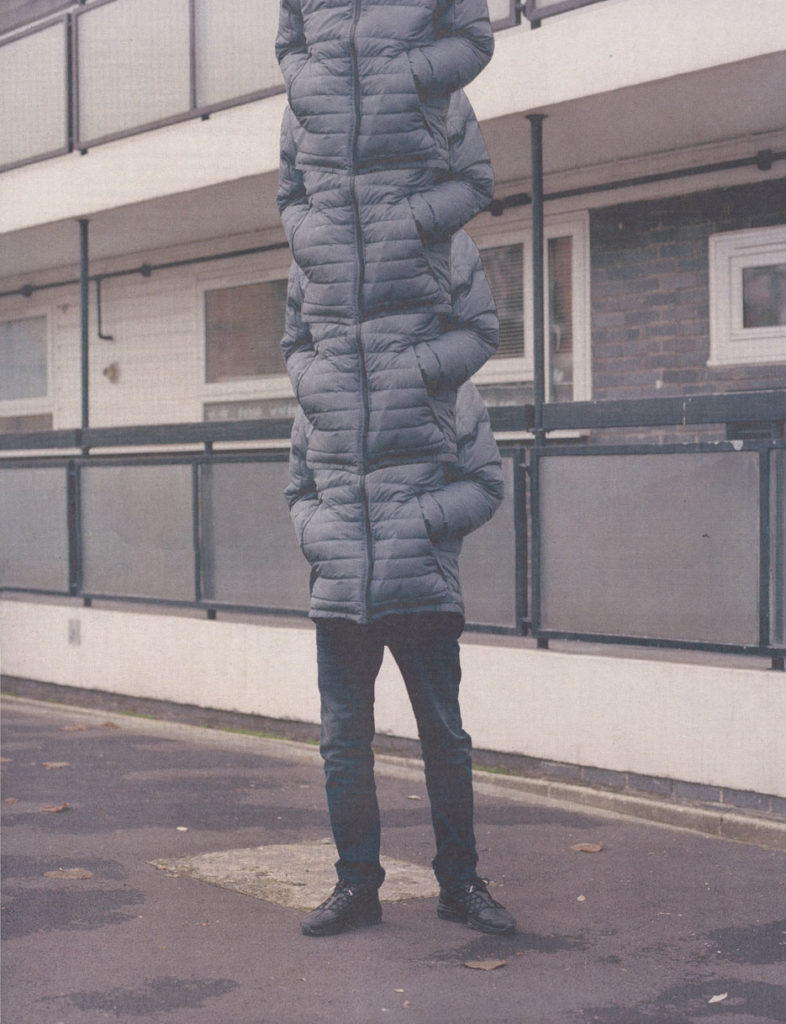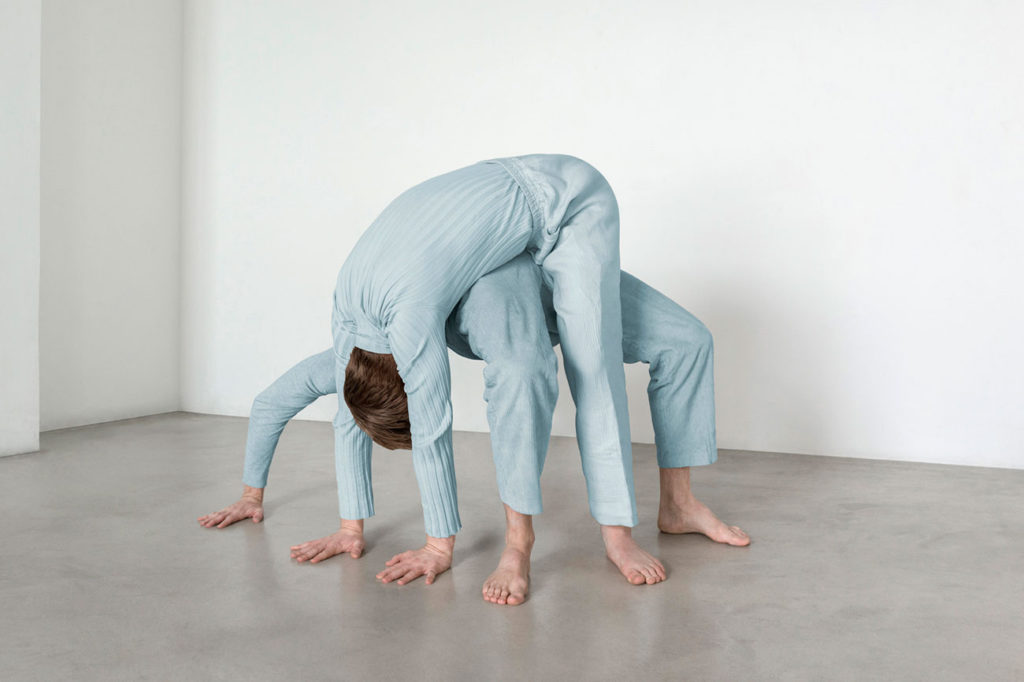Jorge Chamorro is one of Madrid’s early collage movers and shakers. He has been making and exhibiting his direct and witty work before collage became ubiquitous. Jorge is now based in Berlin and he not only makes collage but is thinking about it and its impact on culture and society. In this interview, he shares his latest ideas about what collage has turned into.

TWS –How did you start making collage? When was that? How it happened?
It was in the spring-summer of 2006, and it was something totally accidental, as the important things use to happen.
I was going to spend some holidays in Portugal with my then girlfriend, who was a ceramic artist. She proposed me to make collages together and to sell her ceramics and the collages in the street to afford our holidays.
So, one evening my girlfriend came home and we started to make collages. Soon she got tired and went to bed. I just couldn’t stop, I was on fire, totally absorbed, I spend all night working with an enthusiasm that I won’t forget. I remember that night as if it was yesterday. And I kept on working the day after, and the day after…. I discovered something as simple as the power of paper, the magic of imperfection and random; the joy of working without a brief and without a purpose, just being free.
TWS –Have you had any previous experience before that?
At that time I had just taken part in a collage workshop run by (the Madrid based artist) Sean Mackaoui, where I learned that collage could be something simple, clean and straightforward, because the word “collage” in my mind meant something with many layers and a lot of visual noise. I had no idea about collage and I didn’t know who Sean Mackaoui was, I don’t know why I took part in that workshop, but I guess I was looking for something creative, something more free than my graphic design work for my clients and maybe a way to express my self without a computer, and I didn’t have any skills in fine arts, so why not to try collage. Now I think I also was attracted by things related to collage, without knowing it. Dada, surrealism, punk, do it yourself culture…
At the same time, visual language was familiar to me, I’ve been a graphic designer for many more years than collage artist, so I was used to work with images, composition, color, concepts…. And I think my design work influences my collage work and viceversa which. As my work as a teacher influences somehow my work as a designer or an artist, and viceversa as well. All of them are very different things, but I feel them like three rivers that go to the same sea, or something like that.


TWS –How would you describe the “collage scene” from that period? And how has it changed since then?
First of all, as I said before, I had no idea about collage at that time, so I knew even less abut the collage scene. Very soon I discovered that only few people were doing collage in Madrid at that time. Collage artists were an exception, in Madrid and everywhere. Some artists made collage as something parallel to their usual art discipline, but “pure” collage artists… hardly any. Of course not this avalanche, not this amount of Facebook groups… not at all.
Few years later everything started to change. In 2009 James Gallagher curated “Cutters”, a collective collage exhibition in New York. I think James Gallagher is one of the ones that made the current collage scene possible. There was a need of something to bring the people together, and I think James Gallagher provided this by curating the collage shows and books when the scene still wasn’t established. You, Rubén B. and The Weird Show are also responsible, as also Dennis Busch was with his “The Age of Collage” books and exhibitions. And many more people and projects, of course. I’m mentioning (with the little knowledge I have about this) those I know better and those I know were there for a relatively long period of time, when the scene was starting.
TWS –Madrid soon had a particularly active collage scene at that time…
Everything seemed pretty dead around collage, as everywhere, I guess. SlowIy I could see more interest, more artists, but still very few. Then, in 2013 Sr. García and Elisa Sobelman had the idea to gather the people that were making collage in Madrid. That became in the Sociedad de Collage de Madrid. Initially we were seven or eight artists, not more, just because we didn’t know more people working with collage. We just met to get to know each other, work for a while together in a big table and have a beer together. In just a few weeks we were many more people. Every week there was somebody new. I think it lost a bit of the initial freshness and maybe it it turned into something more commercial.
Anyway, I only took part in the early beginning because at that time I moved to Berlin. Berlin, the city of collage! The city of Dada! So, what I saw in Berlin is that there were many people doing collage, but there was not a scene, the people were not connected, nobody knew anybody. And, again, collage world was still not as big as now. Now there’s much more connection among collage artist in Berlin, there are more events… but the same happened everywhere, in many cities are collage collectives. The scene today and just a few years ago has changed a lot everywhere.


TWS –And what was your feeling about collage as an art form?
I always say that collage is to art like punk to music, something like the “small brother”, something not taken very seriously, like a “minor” art, something you don’t need specific skills as to play a piano or to paint an oil… which I think is good and bad at the same time but I like it, I must say. So, back then, everything was more “punk”, less serious, nobody expected to make a living out of collage (that didn’t change very much). I remember collage exhibitions where nobody framed the works and now it’s strange to see an exhibition with unframed collages. I still don’t frame!
Now collage became a trend, there are specific collage festivals, specific publications, specific websites like yours… Lets see how long it lasts, but we already know that trends always disappear sooner or later. On the other hand, nothing changed, collage is still the “small brother”, the discipline everyone can do… but this is also the beautiful thing of collage. So, I think the trend will pass but collage won’t.


TWS –Why do you think collage (as an art form and as a language) has become a trend over the latest years?
Of course, I’m not sure, but I have some speculations and conjectures that I’ll try to explain:
One reason is that in general there is need of going “back to the roots”. Folk music, for example, lo-fi music, is now much more popular than some years ago. In the era of computers it’s natural to have this kind of reaction. The beauty of torn paper instead of the perfect straight line of the computer, the sound of a banjo instead of the techno sound, to work with our hands instead of the mouse, the vinyls are also coming back, more young people are living in the countryside…
Another reason is what they call “democratization of art” and the easiness to show it on internet. And collage is very easy technically and very cheap, so everyone can have access to it very easily.
And maybe there are other more hidden reasons. All the moments in history when collage was more popular were always in periods of crisis, confusion and absurdity and where capitalism was specially devastating. Dadaism and Surrealism after the First World War, Pop Art after the Second World War, Situationism before May 68, Punk in the 70’s… And nowadays, where we have another crisis (or many crisis at the same time) and capitalism is really cruel. In the era of communication and globalization societies and human relationships are more and more fragmented, and in collage we work with fragments literally. The exposure of our happiness in social media coexist with our loneliness, the countries we use to think as the most developed are those where the people are more alone. The absurdity is very present in our days. And if there’s a “number one theme” in collage is that one: the nonsense, the absurdity. I think we are not able to understand or accept our reality and we have to rebuild and to invent new realities. And that’s collage basically, I think.

– After working many years in collage and being involved in the collage community, you started coining a new term to talk about what collage has transformed into: Post Collage. How did you started thinking about this idea What is Post Collage for you?
I called Post Collage to the the massive “language of collage” we can see nowadays in every art discipline, not only in the “traditional” cut and paste collage.
Analog collage (and digital as well) is now possibly in its most popular moment since the Avant-garde movements of the early XX Century. Actually, we can say it’s a trend. Over the past few years this form of expression that plays with juxtaposition, addition, subtraction, decontextualization and re-contextualization of images and meanings is not something exclusive of the artists with scissors and glue (as it never was). More and more artists from other disciplines are working with the same vocabulary. Not cutting and pasting with papers, scissors and glue, but taking this approach to sculpture, photography, performance, animation, videoclips, graphic design or painting. And it’s not only the idea of using juxtaposition, but also the way of approaching its subjects. Surprise, humor, absurd or mystery, are not, of course, inventions of collage, they are in every art form (as they are in life), but they were explored and developed in depth by collage artists. And now I can see the same kind of discourse in many other disciplines. So, more than ever, we can say we do live in the “era of collage”, but not referring only to the proliferation of cut and paste artists but also to its language, approach and vocabulary. Traditional collage has influenced in other fields and these fields have also influenced cut and paste collage. There is a mutual feedback, I guess.

TWS –I recently read about Graffiti and Post Graffiti, that is somehow related to what you’re exposing. While Graffiti has a lot “rules” that a writer need to follow to be accepted and respected by the Graffiti community to which they are addressing, Post Graffiti is a more open notion of public art, with no strict codes to follow and aimed at the general public.
When you are talking about Post Collage I can think of something similar. When collage was adopted by other people far from the collage scene, it has mutated into something else. Does this makes sense?
It is very similar to this, as every “Post something”. Graffiti is a very particular case just because of its essence: legality, vandalism or art, the use of the public space, the transition from the street to the gallery…. Graffiti and Street Art have a very particular universe. Graffiti, Street Art, Post Graffiti are not only art disciplines, they are also movements. I could say collage is a movement, it has a scene, there are festivals, publications, Facebook groups, etc. Post Collage is not this. It’s just a language, a way to work, a way to express and to communicate. There’s no a specific discipline in common, we can see collage language, as I said, in photography, in sculpture, in design, in painting, in advertisement, in memes… so it’s not an art movement with more or less rules, with a scene and concrete artists. And it’s not something you could say like “this artist makes Post Collage”, because it’s not an art discipline.
When we talk about Post Punk, for example, Post Graffiti as well, we are talking about people directly influenced by Punk, even disliking it, but somehow was a continuation, a consequence, even against the first one. In collage and Post Collage we can’t talk about these kind of transitions. Anyway, the name “Post Collage” is not important at all, and maybe it’s not the most appropriate one, I have to say it’s the name I gave to a document where I wanted to write about this, a short way to give a title to a text where I was trying, first of all, to explain myself this collage and collage language invasion.
And thinking about Graffiti and Street Art, I realize that they have other connections with collage. The oldest and essential game in collage, the core of it, I would say, which is: What is this doing here? Street Art plays the same game: What is doing this in this street, wall, etc. Banksy is pure collage. Mark Jenkins is pure collage as well. Another thing in common is that both art forms have to deal with legality in one way or another. In Street Art with the use of the public space and in collage with copyright. Both play with material that already exists… There are things in common, for sure, between collage and Graffiti, Street Art… Actually, many collage artists worked or work with Graffiti.
But it’s not the same transition, it’s not that a collage artist becomes Post Collage artist or something like that. Well, who knows. The beautiful thing of all this is that it’s not about the “label”, it’s not about the box, it’s not about the borders but the opposite: how the borders disappear. It’s not what influences what, or what came first, but how much richer is the panorama when art becomes open. It’s about the eternal recycling that art and culture are about. And in collage, borders are a big thing. Eunice Parsons said something like “My whole life is about borders”.

TWS –Cut and paste has become a common element in society. I mean, cut and paste are two actions that are embedded in our daily life in a way that we don’t even realize. Collage mindset dominates our daily life without us even thinking of it every time we use our mobiles, computers, social media, etc.
So, Is this one of the elements that might help creating this “Post Collage” thing that is transversal to art and culture?
It’s certain that we live in a cut and paste mindset. And not only in our mobiles, computers and so. The discourse we read and see in the media is based on fragmentation. TV first, and internet later, have changed completely the way we receive information. Nobody reads a text in a screen more than 5 minutes. In TV long interviews just don’t exist anymore, for example. The only way to learn something about whatever is to get deep into it. And the way we read now makes learning really difficult. In internet we just chop a little here and a little there, but we don’t let ourselves enough time to assimilate anything. I see a big danger in this, because if we don’t learn we are much easier to manipulate. So internet is the window to the world, but does it really make us wiser? The same “collage mindset” happens to our expectations in life. Before, people wanted a house, a job and a couple forever, and now we want to have many couples, to change our jobs, our home… Tinder and this kind of applications are another example of this fragmentation. Now the “most loyal relationship” people have is with series in Netflix. For sure there’s a lack of continuity in general. The narrations we receive are not lineal, but our life is. And I think that’s quite strange and we can’t see the consequences yet. But probably they won’t be good. I think this flexibility of globalization is the perfect breeding ground for capitalism, as this era of communication is for isolation, or the knowledge in one click to ignorance.
Finally: is all this helping to create this “Post Collage thing”? Difficult to say. But probably it’s not a coincidence. Art is always a consequence or a reaction to the time people live in. And it’s not only in art, cut and paste collage or other art disciplines, it’s also in communication in general. Advertising, design… But also things that come from the people, not from professionals of communication. Memes are pure collage language.
The basic game in collage is decontextualization and recontextualization, although, of course, this is not an invention of collage artists. So, I think we live in a time of decontextualization in general, and we have no idea if there will be a time of recontextualization. In the meanwhile, we make collages trying to recontextualizate something at least in our table.






